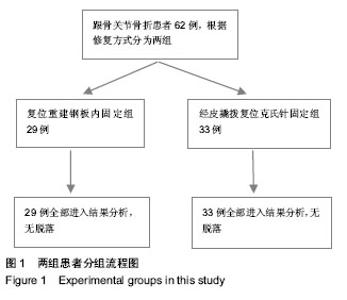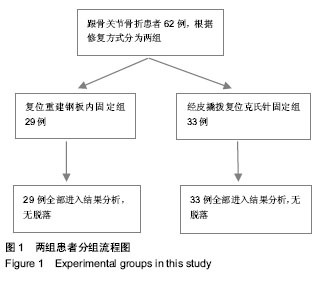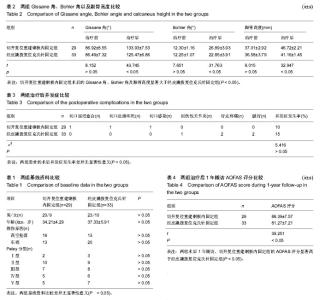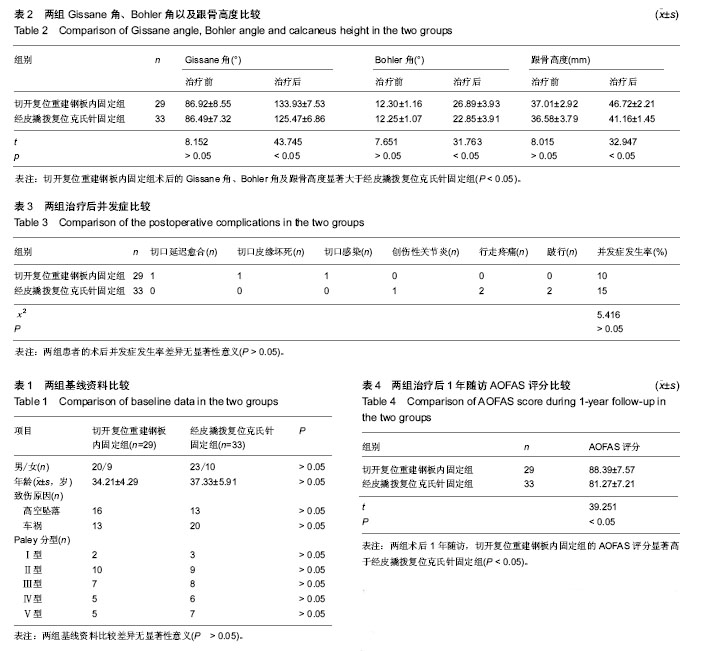| [1] 王海立,苏艳玲,杨宗酉,等. 2003年至2012年河北医科大学第三医院成人跟骨骨折的流行病学分析[J].中华创伤骨科杂志, 2014, 16(5):406-409.
[2] 赵津刚,刘玉强.跟骨骨折治疗现状[J].医学综述,2011,17(13): 1993-1995.
[3] 刘长松,王波.107例跟骨骨折术后疗效及并发症浅析[J].中华创伤骨科杂志,2011,13 (8):793-795.
[4] 李伟,张克民,陈雪梅,等.微创小切口钛板内固定治疗跟骨骨折[J].中华损伤与修复杂志(电子版),2012,7(5):506-511.
[5] 郭宗慧,庞清江,刘江涛,等.载距突螺钉内固定治疗SandersⅡ型跟骨骨折的生物力学研究[J].中华骨科杂志,2013,33(4): 331-335.
[6] 高彦军.改良扩大跟骨外侧"L"型切口治疗跟骨骨折疗效分析[J].中华实用诊断与治疗杂志,2011,25(5):510-511.
[7] 李伟,潘显明,王艳萍,等.20例跟骨关节内骨折的手术治疗[J].重庆医学,2010,39(12):1576-1577.
[8] 王攀峰,付青格,刘欣伟,等.两种手术方法治疗跟骨骨折的病例对照研究[J].中国骨伤,2012,25(2):92-96.
[9] 李志权,闵敏,苏以林,等.切开复位内固定治疗移位跟骨关节内骨折37例[J].广东医学,2012,33(5):642-643.
[10] 王岩,龚晓峰,王金辉,等."双楔形"植骨距下关节融合术治疗复杂跟骨骨折畸形愈合[J].中华创伤骨科杂志,2010,12(7): 651-654.
[11] 赵恺,王军伟,梁晓军,等.跟骨多方位截骨加植骨与距下关节融合术治疗严重跟骨骨折畸形愈合[J].中国骨与关节外科,2013, 6(4): 373-375.
[12] 王大鹏,楚永杰,郭自斌,等.距下关节牵伸骨块植入融合术治疗跟骨陈旧骨折12例分析[J].中国误诊学杂志,2010,10(30): 7524-7524.
[13] 么贵军,尚剑.跟骨骨折的生物力学研究进展[J].中华创伤骨科杂志,2014,16(9):803-805.
[14] 陈信军,胡德志,曾林,等.异型钢板治疗波及跟距关节的跟骨骨折[J].国际骨科学杂志,2011,32(4):268-269.
[15] 严广斌. AOFAS踝-后足评分系统[J].中华关节外科杂志(电子版),2014,8(4):557.
[16] 韩明建,王志杰,邹云雯,等.锁定跟骨钢板治疗新鲜跟骨骨折[J].中华骨科杂志,2011,31(4):335-338.
[17] 彭光军,王荣华,衡德峰,等.跟骨骨折不同内固定方法治疗的比较研究[J].中国矫形外科杂志,2010,18(20):1686-1688.
[18] Vittore D, Vicenti G, Caizzi G, et al. Balloon-assisted reduction, pin fixation and tricalcium phosphate augmentation for calcanear fracture. Injury. 2014;45 Suppl 6:S72-79.
[19] 胡东山,罗逸林.内固定治疗跟骨骨折68例疗效观察[J].中国老年学杂志,2013,33(18):4588-4589.
[20] 曹立海,彭义,曲家富,等.双跟骨骨折的手术治疗及疗效分析[J].中国骨与关节损伤杂志,2011,26(2):186-187.
[21] 赵志,尚希福,周新社,等.跟骨骨折不同治疗方法的临床疗效观察[J].中华全科医学,2013,11(1):18-20.
[22] 陈志伟,杨乐忠,吴文特,等.切开复位内固定治疗SandersⅢ型及Ⅳ型跟骨骨折[J].中国骨伤,2011,24(8):641-644.
[23] 陈晓明,马华松,刘玉增,等.克氏针撬拨结合钢板置入内固定与局部植骨治疗跟骨关节内骨折[J].中国组织工程研究与临床康复, 2011,15(39):7331-7334.
[24] 张小海.撬拨复位跟骨解剖型钢板内固定治疗跟骨骨折22例[J].中华损伤与修复杂志(电子版),2011,6(3):432-434.
[25] 陶忠生,冯亚高,王巍巍,等.跟骨骨折术后钢板外露的显微外科治疗[J].中华显微外科杂志,2012,35(2):173.
[26] 温建强,李逸群,陈国涛,等.小切口结合手法整复克氏针内固定治疗Sanders Ⅳ型跟骨骨折[J].中华创伤骨科杂志,2014, 16(3): 271-273.
[27] 谢鸣,方真华,赵晶晶,等.Ilizarov外固定支架治疗StephenⅢ型旧性跟骨骨折畸形愈合[J].中华创伤骨科杂志,2011, 13(2):135- 139.
[28] 曹立海,杜晓健,吴俊,等.手术治疗有移位关节内跟骨骨折的临床观察[J].中华临床医师杂志(电子版),2013,7(4):1798-1799.
[29] 梁军,辛景义,曹红彬.跟骨移位关节骨折的手术治疗[J].中华医学杂志,2012,92(21):1492-1494.
[30] 赵志,尚希福,周新社,等.跟骨骨折不同治疗方法的临床疗效观察[J].中华全科医学,2013,11(1):18-20.
[31] 陈滨,黎润光,王钢.跟骨骨折的手术治疗策略及疗效分析[J].中华创伤骨科杂志,2010,12(8):746-751.
[32] 李明义,史会明,刘晓波,等.撬拔与切开复位治疗SandersII-IV型跟骨骨折的临床分析[J].医学综述,2011,17(19):3023-3024.
[33] 朱永展,李逸群,吴峰,等.早期清创复位克氏针内固定与Ⅱ期钢板内固定治疗开放性跟骨骨折的病例对照研究[J].中国骨伤,2012, 25(2):103-108.
[34] 张小兵.经皮撬拨复位克氏针固定术与切开复位钢板内固定术治疗跟骨骨折对比研究[J].中国医药导报,2012,09(14):54-56.
[35] 吴晓明,高伟,李凡,等.锁骨钩钢板内固定术后并发症分析与防治对策[J].中华骨科杂志,2012,32(4):331-338.
[36] 华荣,孙建飞,惠利民,等.累及跟距关节的跟骨骨折内固定术后皮肤感染及坏死的临床探讨[J].中华损伤与修复杂志(电子版), 2011,06(6):970-974.
[37] 王震.小切口与“L ”型切口治疗跟骨骨折疗效及并发症的对比研究[J].中国矫形外科杂志,2013,21(14):1402-1405.
[38] 龙秋瑚,阳慧敏,罗燕,等.跟骨骨折术后切口皮缘坏死及感染的临床分析[J].中华医学感染学杂志,2013,23(16):3957-3958.
[39] 赵军放,侯新安,刘争民,等.跟骨骨折切开复位内固定术后切口并发症原因分析[J].中国骨与关节损伤杂志,2011,26(12):1145-1146.
[40] 贾斌,张勇,曹国庆,等.跟腱旁小切口克氏针内固定治疗跟骨关节内骨折[J].临床骨科杂志,2011,14(1):55-57.
[41] Zeman P, Zeman J, Matejka J, et al. Long-term results of calcaneal fracture treatment by open reduction and internal fixation using a calcaneal locking compression plate from an extended lateral approach. Acta Chir Orthop Traumatol Cech. 2008;75(6):457-464.
[42] Lin CX, Shi ZY, Xu YM,et al. Treatment of calcaneal fractures by fixation of Kirschner needle and thread cancellous bone screw through sinus tarsi interstice. Zhongguo Gu Shang. 2014;27(7):551-554.
[43] Wallin KJ, Cozzetto D, Russell L, et al. Evidence-based rationale for percutaneous fixation technique of displaced intra-articular calcaneal fractures: a systematic review of clinical outcomes. J Foot Ankle Surg. 2014;53(6):740-743.
[44] Wang HH, Wang J, Song XQ, et al. Case-control study on cancellous screw and compression bolt in the treatment of calcaneal fractures wih minimally invasive plate. Zhongguo Gu Shang. 2013;26(2):134-137.
[45] Fu TH, Liu HC, Su YS, et al. Treatment of displaced intra-articular calcaneal fractures with combined transarticular external fixation and minimal internal fixation. Foot Ankle Int. 2013;34(1):91-98.
[46] Zhu YZ, Li YQ, Wu F, et al. Case-control study on therapeutic effects between Kirschner wire fixation after early bebridement and staged plate fixation in the treatment of open calcaneal fractures. Zhongguo Gu Shang. 2012;25(2): 103-108. |



